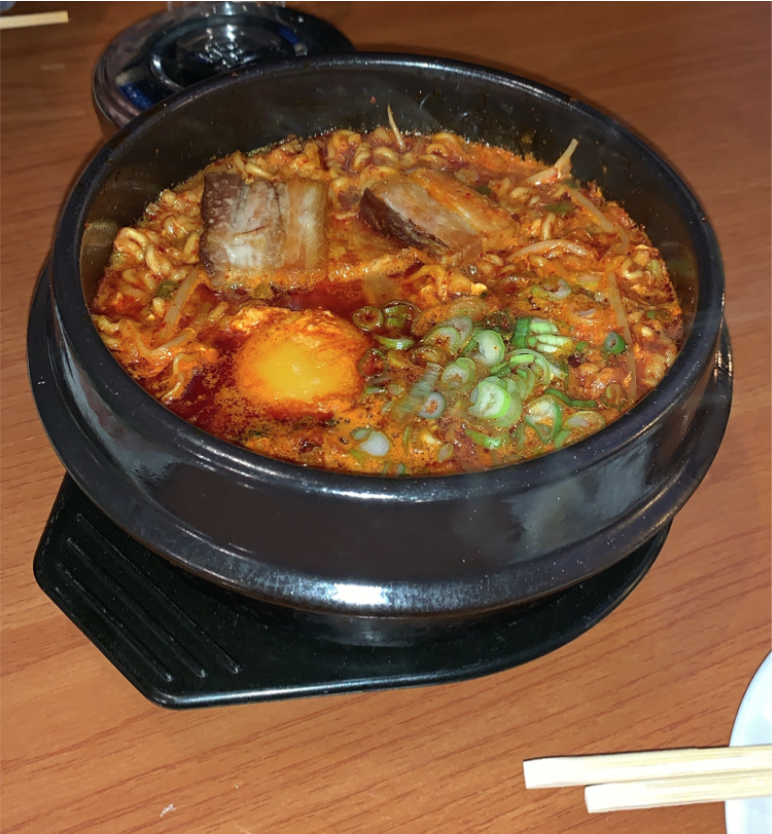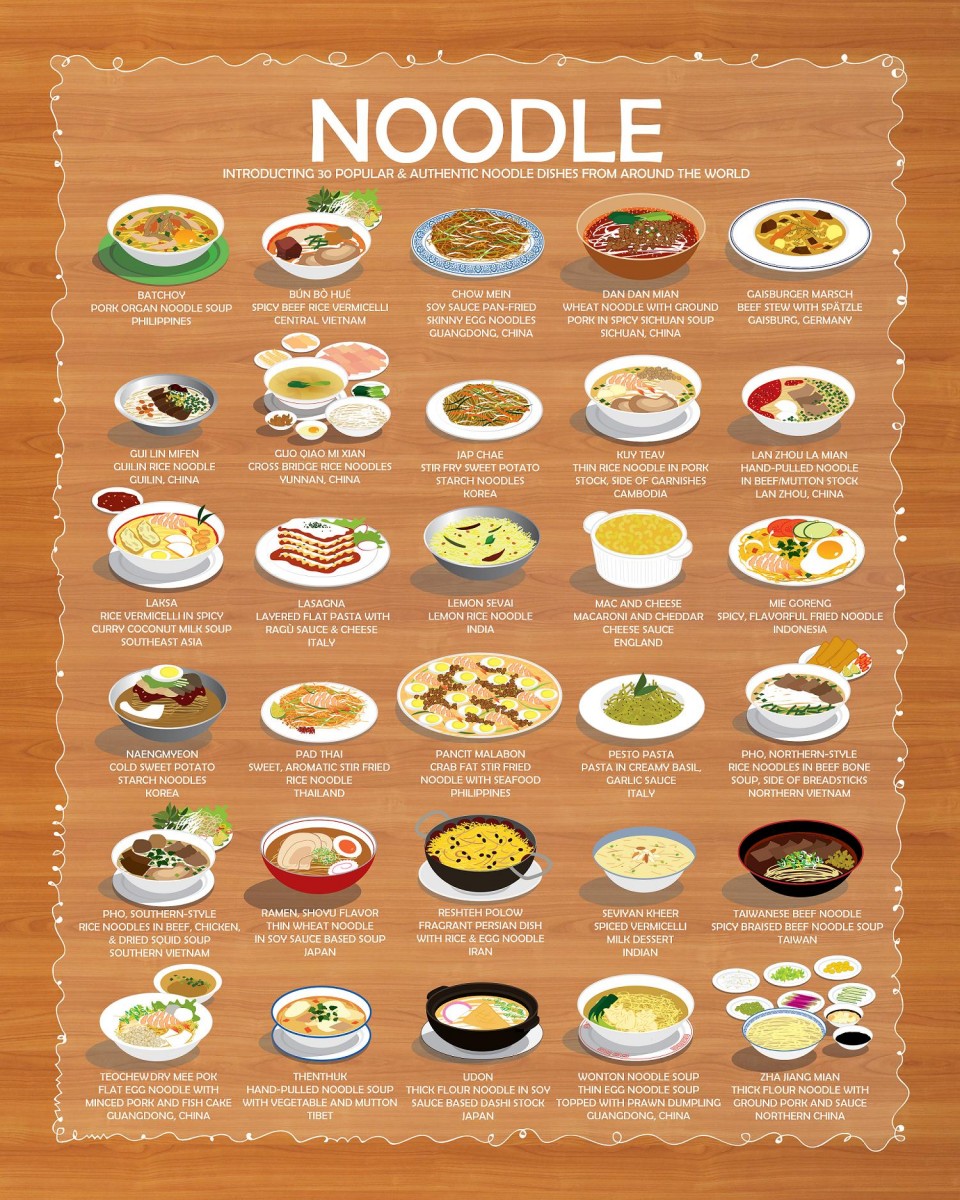
Delicately drawing a cluster of thin wheat noodles to her lips, I watch as a wave of bliss carries over the woman at the table next to me. Her cheeks immediately flush a rose color as the corners of her lips slowly curve upwards. She gestures for the man sitting across from her to try the soup. His face hovers over the bowl as steam clouds his reaction. He draws a bundle of noodles from the pot and suddenly a magical smile sweeps across his face. A smile that emulates a growling stomach being soothed by the slick flow of ramen noodles sliding into his impatient stomach. It seems as if their love for each other is shared through this oversized clay pot of noodles. They take turns experiencing the love and the warmth of the soup; of each other. The waitress shuffles over to ask for my order but I cannot seem to break my gaze from the steaming pot of ramen noodles. I am unable to hear her over the powerful slurps of noodles that the couple next to me alternatively takes with each mouthful. The waitress patiently repeats the question. My gaze is shattered and I eagerly reply, “I’ll have what they are having please!” Hesitantly, the waitress informs me, “I must warn all customers, our ramen is extremely spicy…if you’re okay with that.” My mouth begins to salivate, “Of course, bring it on!” Not long after, the same oversized black pot flooded with ramen, drenched in seasoning, sprinkled with chives is carefully placed in front of me.
My ethnographic observation of ramen noodles continues, this time, from a perspective that is my own. The rich and lightly salted broth coats the noodles, tastefully heating them in preparation for each bite. Slices of pork, protected by a lining of fat, glisten in the boiling soup as spices waft into the air, tickling my nose. I raise the noodles, sopping with broth, steadily to my lips. Almost instantly, my mouth ignites in flames. Sweat crawls down the side of my forehead but I cannot put down the chopsticks to wipe the droplet before it becomes immersed in my eyebrow. I repeatedly lift the noodles to my lips, craving the intense spice and chewy wheat with each slurp. The soup is no longer clouded with spices, broth, and noodles; the clay pot exposes its bare, empty shell. Ramen noodles are like a drug, so addicting. No one can resist the thin yet chewy noodles as they slither across your lips leaving traces of spices and broth. Ramen-lovers crave the dish on the hottest days and coldest nights. It revives the sick and evokes joy in those seeking happiness. “Ramen is one of those things that elicits that kind of nostalgia and longing that people want.” (Moskin, The New York Times). The renowned New York Times Food author, Julia Moskin, perfectly encapsulates the essence of ramen noodles in a simple sentence. Ramen is such a dominant noodle dish in many countries. The harmony of spices swirled among the infinite noodles is what lures customers hungry for satisfaction. Ramen brings flavor to the lives of those who consume them. Although many seem to enjoy the dish, very few have stopped to study the noodles within the broth and understand their history. I have taken the time to ask the question that many wonder but few ask: the question of how ramen noodles became such a revolutionary noodle dish in Eastern Asia as well as across the world in other countries such as The United States.
Just as historians argue on the topic of how the noodle traveled along the silk road between China and Italy, many ponder the same questions about ramen noodles transported between China and Japan. The question as to who formulated the first bowl of ramen noodles remains a fight between the two countries of Eastern Asia. The history of ramen is spicier than the dish itself. While many people claim that ramen noodles originated in Japan, historical evidence proves this statement wrong. Renowned professor and author of “The Untold History of Ramen Noodles: How Political Crisis in Japan Spawned a Global Food Craze”, George Solt, unraveled the dish that has become a favorite across the world. Professor Solt, partially blind to the gustatory aspects of the dish, approaches his views of ramen strictly from a historical standpoint. While he is overwhelmingly educated in every detail involving the complex origin and history of the noodles, his taste buds are lacking perspective. In fact, he does not know how to make ramen nor does he know the best places to find the dish in one of the largest hubs of ramen noodle soup, New York City. This, though, surprisingly makes him an adequate source to determine the true root of ramen. He is now easily able to set aside all personal feelings for the noodles in order to zoom in on solely the facts. For years, Professor George Solt unraveled the tangled history of ramen as the soup “evolved over the decades from a staple of the Japanese working class, to a mainstay of American college students now, to one of New York’s trendiest foods” claims Alison Herman in her article The Messy History of Ramen. He notes that while ramen noodles are a staple food of Japan, they originated in China. How the infamous noodles immigrated from one coast to the other remains a question even for Solt. The path of ramen noodles is merely a theory supported by historical facts that Solt has pieced together.
While, the history of the origin of ramen noodles still remains cloudy, Professor George Solt is able to clear some of the confusion and claims with a few concrete facts. In his acclaimed novel, “The Untold History of Ramen: How Political Crisis in Japan Spawned a Global Food Craze,” Professor Solt notes that Ramen did not originate in Japan as many would like to believe. In fact, the Chinese noodle dish, he claims, was brought to Japan from Chinese traders about two centuries ago. Many people choose to believe that the Japanese discovered the irresistible noodle soup, though, because “ramen is one of the most minutely document foods in Japan,” he insists. The dish conquered Japan in a time of increasing development, rising from a blue-collar associated soup to a high class, soon to be, world renowned dish. It is for this reason that many maintain the belief that ramen originated in Japan rather than China. Ramen grew alongside the development of Japan, so the rest of the world viewed the two hand in hand which completely erased China from the history of the noodle dish. While Solt believes in the theory of ramen noodles sailing to Japan via Chinese tradesmen, he continues to mention several other theories involving the journey of ramen from China to Japan that he claims to be more plausible. These theories are more credible in the sense that they are more recent in time and therefore are able to be supported by more documentation and evidence.
One of Professor Solt’s additional theories that he mentions tells of a customs agent, originally from Yokohama, China, who opened his own ramen shop in Tokyo, Japan called Rai-Rai Ken. The Chinese native welcomed his first Japanese customers in 1910. He employed only Chinese chefs, skilled in noodle preparation. The now world-wide famous restaurant, Rai-Rai Ken, is responsible for the popularization of a dish many Japanese came to know as “Shina Soba”. Author Alison Herman explains the literal translation behind the dish in her article The Messy History of Ramen. She writes, ““shina soba”: shina for China, soba for the noodle dish already well established in Japanese cuisine.” The noodle dish, or ramen noodle soup, was literally identified by the Japanese as Chinese noodles. This explanation of ramen noodles is much more factual and conceivable when analyzing the history of the origin of the dish. One reason this story may not be highlighted in the common history of ramen, though, is due to the expulsion of the noodles from Japan and China. Not long after the opening of Rai-Rai Ken, ramen noodles were viewed as illegal in the two countries as a result of the rise of World War II. In his novel, Professor Solt explains, “Selling ramen could and did land people in jail.” Today, marijuana is more legal in the state of Massachusetts than the harmless noodle dish was after being outlawed in the 1940s in Eastern Asia. Various factors such as the famine as well as limitations on the entrance of certain food items including wheat into the country during the war led to the criminalization of selling such noodles. The initial revolution of ramen was now completely demolished by the war, simultaneously wiping away the Chinese reputation associated with ramen noodles.
Upon the rebirth of ramen noodles, the dish began to identify as a part of Japanese culture to other countries. The revival of ramen and identification with Japan arrived at a time of industrialization. Post WWII, ramen noodles once again became acceptable in Japan. This was due to factors such as cheap, accessible flour provided by the United States as well as a longing for Chinese inspired noodles by Japanese soldiers returning form the war in China. Each of these factors, along with others, influenced the resurfacing of ramen noodles in Japan and the commencement of one of Japans most notable dishes around the globe. As Japan rapidly industrialized, so did its noodles. The Japanese took hold of the opportunity to revolutionize ramen noodles and quickly made them their own. National Geographic writer Nancy Gupton depicts ramen as, “A nuanced noodle soup, it was carried from China by tradesmen in the 1800s but brought to life under the hands of Japanese cooks.” Nancy makes an interesting point involving the culture and identity of ramen noodle soup. Clearly knowledgeable on the history of ramen, she acknowledges the proper origin of the dish but takes a different stand culturally. Nancy attributes the idea to the Chinese but the final product and much of the credit to the Japanese. The Japanese were able to insert the raw DNA of their culture into the once Chinese inspired ramen noodles, making the dish their own.
The Japanese were able to claim ramen as their own by inserting their culture into the noodles of the dish during the industrialization of the country. The migration towards major cities in Japan brought a demand for increase in pace among the daily lives of the Japanese. The alteration in the country resulted in an opportunity for the Japanese to identify as a country with ramen noodles. The World of Instant Noodles Association explains, “It was the time when the advent of television as new media was about to drastically change people’s consumption patterns.” The drastic shift in Japanese lifestyle meant that the culture of Japanese food simultaneously had to develop into a more immediate eating culture. Momofuku Ando, the creator of the infamous instant ramen noodles, was among the first to seize this opportunity. Momofuku was able to culturally influence not just Japan, but the entire world with his minute made noodles. Ramen noodles suddenly began to develop from a Chinese soup to an instant dish, ultimately molding into the identity and culture of Japan. The accelerated lifestyle of the Japanese had now become embedded into the noodles of ramen. Momofuku completely revolutionized the market of ramen with his brilliant design. It is no surprise that such an innovative take on food spurred out of Japan as the country is notably “one of the world’s most literate and technically advanced nations” according to U.S. news. What is now recognized around the world as Cup Noodles, paved the way for a new and improved market for instant food. Cup Noodles was progressive in that the entire process of packaging, storing, cooking, and eating could be contained in this single Styrofoam cup. Momofuku completely eliminated physical waste of various materials needed as well as the elimination of time wasted to actually make the soup. This design promoted the rapid lifestyle of Japanese both from the vendors perspective as well as the consumers. Even beyond these instant ramen cups, customers within physical ramen shops can be found hunched over their bowl noodles, quickly slurping their soup. There is no time to be wasted in the eyes of the Japanese. Japan embedded their rapid lifestyle into the dish, evolving ramen noodles for customers on the go; those who crave a good meal but do not have the time for one.
In addition to the influence on Japan as a country, the Japanese-inspired instant ramen noodles have also managed to affect the culture of people over 6,000 miles away in The United States. Instant ramen today is almost unrecognizable, culturally, from the recipe of ramen brought to Japan about two centuries ago. The significance of instant ramen has evolved from Shina soba, which literally translates to Chinese noodles, into a late-night snack for desperate college students. Similar to Japan, The United States is also a highly industrialized country, allowing ramen noodles to perfectly slide into the American lifestyle. Today, in The United States ramen signifies a cheap and accessible food to satisfy hunger. The average instant cup of noodles contains a whopping 875mg of sodium in a single serving. This is over fifty percent of the recommended daily sodium intake. Given this shocking health deficit, many people wonder why the dish remains influential in both Japan and The United States. Those who consume ramen, though, are not necessarily concerned with maintaining a healthy lifestyle as they are focused on surviving. For those who consume the salt-riddled noodles, the dish culturally signifies convenience. Cup Noodles can be eaten anywhere from the library to the bus, the possibilities are endless. While the introduction of ramen noodles form Japan to the U.S. did not initiate the movement of comfort and convenience in The United States, the noodles did emphasize and instill these principles into the culture of the country. In addition to the influence of convenience on American culture, ramen also impacted the culture of prestige food in the United States. Once manual laborers began to level out in the 1980’s, Americans became obsessed with ramen as a fad or a high-class trend. While instant ramen still remains popular among college students in debt to their universities, the health deficiency of the instant noodles began to worry those who consumed them. Not long after these statistics began to arise, homemade ramen picked up again among a newer class of people labeled as hipsters.
As the old ramen restaurants and street vendors steadily declined, ramen took a cultural shift within The United States towards a growing group known as hipsters. Hipsters are defined by Urban Dictionary as “a subculture of American consumer for whom the idea behind the marketing holds more value than the product being marketed.” Typically young adults in their twenties and thirties, this subgroup of people instantly became fascinated by ramen upon its cultural revival from instant noodle soup back to a Japanese inspired, handcrafted delicacy. Professor George Solt recalls, “Ramen chefs were appearing on television, writing philosophical treatises, and achieving celebrity status in Japanese popular culture, while their fans were building museums and Internet forums.” As the industrial era faded, so did the culture of minute made noodles among many Americans. Cup noodles still remain popular among certain subcultures; however, hipsters are paving the way for the arrival of a new cultural significance of ramen which is the polar opposite of instant ramen. With the help of hipsters, ramen gained a high-class status. The noodles now culturally signify wealth and social status among other meanings. This shift in the cultural significance of ramen among Americans highlights the everchanging presence of ramen. There is no singular meaning of ramen noodles, which leads many to believe that it may not necessarily be the dish that is altering the culture of each country, but rather the country that is altering the DNA of the noodles within the soup.
While historical facts prove that ramen is from China, the food is globally identified with Japan. So, the question still remains of how ramen influences Chinese culture, if at all, and what exactly happened to the dish following the ramen expulsion in China during WWII. The answer to this is simple yet complex. The simple answer is that no current dish in China resembles the ramen noodles exported world-wide from Japan today. However, this does not mean that ramen remained completely exiled from China. This simply means that most ramen recipes consumed by the Chinese are exported from Japan. In fact, China is the number one consumer of instant noodles in the world. This is in part due to the overwhelming population of the country although another main reason was the 2014 earthquake that resulted in a need for easily accessible food. While the ramen recipes scattered throughout China are no longer distinctly Chinese, the country is still greatly influenced culturally by the dish. In China, noodles signify expression of love for one another regardless of the origin of the noodles. The Chinese choose to focus on the culinary aspect of the noodles along with the cultural significance shared among the people they are eating their noodles with rather than a few uncertain historical facts.
Ramen noodles remind the Japanese of their history and culture. Although this specific type of noodle did not originate in Japan, this does not mean that they cannot hold cultural significance to the country. The cultural significance of the noodle dish alters based on the table the ramen is being served at. The meaning behind the dish is as fluid as the ramen noodles floating in broth. Just as it is difficult to pinpoint the exact origin of ramen and when it immigrated from China to Japan, it is difficult to pinpoint a specific cultural meaning of ramen noodles. The consumer defines the meaning of the noodle whether it signifies survival, love, or prosperity. Within each simmering bowl of flavored broth, lies a scramble of noodles intertwined with ajituski tamago (ramen egg), coated with chili flakes, star anise, and negi (shredded green onion). “Thanks to its affiliation with urban workers, it also became the object of nostalgia for a time when Japan was still on the rise rather than settled into affluence.” (Messy History of Ramen Herman). The Japanese were, and still are, proud to embed their cultural DNA into the squeaky Styrofoam cup of dried noodles and the writhing wheat noodles of homemade ramen. They continue to instill their own unique meaning into ramen, different from that of the Chinese and Americans. It is this aspect of the dish that makes ramen so popular throughout the world. Ramen is easily adaptable to any restaurant, any home around the world. No matter what table ramen is served on, the dish is sure to hold a unique cultural significance with each bite.
Sources:
- https://firstwefeast.com/eat/2014/05/george-solt-on-the-messy-history-of-ramen
- https://instantnoodles.org/en/noodles/index.html
- https://www.newyorker.com/culture/annals-of-gastronomy/americas-ramen-obsession-from-maruchan-to-momofuku
- https://www.nytimes.com/2004/11/10/style/dining/here-comes-ramen-the-slurp-heard-round-the-world.html
- https://www.newyorker.com/culture/culture-desk/the-history-of-the-ramen-noodle
- https://www.usnews.com/news/best-countries/japan
- https://www.tofugu.com/japan/history-of-ramen/
- https://timeline.com/ramen-path-global-domination-b4d9831dbce
- https://www.thedailymeal.com/eat/10-things-you-didn-t-know-about-ramen-slideshow/slide-6
- https://www.nationalgeographic.com/travel/destinations/asia/japan/sponsor-content-sushi-and-ramen-japan/







